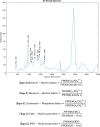Non-Obese MKR Mouse Model of Type 2 Diabetes Reveals Skeletal Alterations in Mineralization and Material Properties
- PMID: 35229063
- PMCID: PMC8861985
- DOI: 10.1002/jbm4.10583
Non-Obese MKR Mouse Model of Type 2 Diabetes Reveals Skeletal Alterations in Mineralization and Material Properties
Abstract
Obesity is a common comorbidity of type 2 diabetes (T2D). Therefore, increased risk of fragility fractures in T2D is often confounded by the effects of obesity. This study was conducted to elucidate the mechanistic basis by which T2D alone leads to skeletal fragility. We hypothesized that obesity independent T2D would deteriorate bone's material quality by accumulating defects in the mineral matrix and undesired modifications in its organic matrix associated with increased oxidative stress and hyperglycemia. To test this hypothesis, we used 15-week-old male non-obese mice with engineered muscle creatine kinase promoter/human dominant negative insulin growth factor 1 (IGF-I) receptor (MKR) and FVB/N wild-type (WT) controls (n = 12/group). MKR mice exhibit reduced insulin production and loss of glycemic control leading to diabetic hyperglycemia, verified by fasting blood glucose measurements (>250 mg/dL), without an increase in body weight. MKR mice showed a significant decrease in femoral radial geometry (cortical area, moment of inertia, cortical thickness, endosteal diameter, and periosteal diameter). Bone mineral density (BMD), as assessed by micro-computed tomography (μCT), remained unchanged; however, the quality of bone mineral was altered. In contrast to controls, MKR mice had significantly increased hydroxyapatite crystal thickness, measured by small-angle X-ray scattering, and elongated c-axis length of the crystals evaluated by confocal Raman spectroscopy. There was an increase in changes in the organic matrix of MKR mice, associated with enhanced glycoxidation (carboxymethyl-lysine [CML] and pentosidine) and overall glycation (fluorescent advanced glycation end products), both of which were associated with various measures of bone fragility. Moreover, increased CML formation positively correlated with elongated mineral crystal length, supporting the role of this negatively charged side chain to attract calcium ions, promote growth of hydroxyapatite, and build a physical link between mineral and collagen. Collectively, our results show, for the first time, changes in bone matrix in a non-obese T2D model in which skeletal fragility is attributable to alterations in the mineral quality and undesired organic matrix modifications. © 2021 The Authors. JBMR Plus published by Wiley Periodicals LLC on behalf of American Society for Bone and Mineral Research.
Keywords: BONE QUALITY; GLYCATION; MINERALIZATION; NON‐OBESE; TYPE 2 DIABETES.
© 2021 The Authors. JBMR Plus published by Wiley Periodicals LLC on behalf of American Society for Bone and Mineral Research.
Conflict of interest statement
All authors state that they have no conflicts of interest.
Figures









Similar articles
-
Induction and rescue of skeletal fragility in a high-fat diet mouse model of type 2 diabetes: An in vivo and in vitro approach.Bone. 2022 Mar;156:116302. doi: 10.1016/j.bone.2021.116302. Epub 2021 Dec 21. Bone. 2022. PMID: 34952229 Free PMC article.
-
Glycoxidation of the Bone Matrix Modulates Mineralization.J Bone Miner Res. 2025 Jun 11:zjaf080. doi: 10.1093/jbmr/zjaf080. Online ahead of print. J Bone Miner Res. 2025. PMID: 40497659
-
Degradation of Bone Quality in a Transgenic Mouse Model of Alzheimer's Disease.J Bone Miner Res. 2022 Dec;37(12):2548-2565. doi: 10.1002/jbmr.4723. Epub 2022 Nov 1. J Bone Miner Res. 2022. PMID: 36250342 Free PMC article.
-
Advanced glycation and glycoxidation end products in bone.Bone. 2023 Nov;176:116880. doi: 10.1016/j.bone.2023.116880. Epub 2023 Aug 12. Bone. 2023. PMID: 37579812 Free PMC article. Review.
-
Effect of type 2 diabetes-related non-enzymatic glycation on bone biomechanical properties.Bone. 2016 Jan;82:21-7. doi: 10.1016/j.bone.2015.07.028. Epub 2015 Jul 23. Bone. 2016. PMID: 26211993 Free PMC article. Review.
Cited by
-
Skeletal abnormalities in mice with Dnmt3a missense mutations.Bone. 2024 Jun;183:117085. doi: 10.1016/j.bone.2024.117085. Epub 2024 Mar 23. Bone. 2024. PMID: 38522809 Free PMC article.
-
Advantages and Limitations of Diabetic Bone Healing in Mouse Models: A Narrative Review.Biomedicines. 2023 Dec 13;11(12):3302. doi: 10.3390/biomedicines11123302. Biomedicines. 2023. PMID: 38137522 Free PMC article. Review.
-
Advantages of omics approaches for elucidating metabolic changes in diabetic peripheral neuropathy.Front Endocrinol (Lausanne). 2023 Nov 28;14:1208441. doi: 10.3389/fendo.2023.1208441. eCollection 2023. Front Endocrinol (Lausanne). 2023. PMID: 38089620 Free PMC article. Review.
-
Bone matrix quality in a developing high-fat diet mouse model is altered by RAGE deletion.Bone. 2022 Sep;162:116470. doi: 10.1016/j.bone.2022.116470. Epub 2022 Jun 16. Bone. 2022. PMID: 35718325 Free PMC article.
-
A Review of Animal Models for Studying Bone Health in Type-2 Diabetes Mellitus (T2DM) and Obesity.Int J Mol Sci. 2024 Aug 29;25(17):9399. doi: 10.3390/ijms25179399. Int J Mol Sci. 2024. PMID: 39273348 Free PMC article. Review.
References
-
- Vaag A. On the pathophysiology of late onset non‐insulin dependent diabetes mellitus. Current controversies and new insights. Dan Med Bull. 1999;46(3):197‐234. - PubMed
LinkOut - more resources
Full Text Sources
